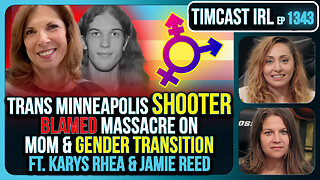Premium Only Content

Reactive Attachment Disorder and Borderline Personality Disorder - RAD and BPD
Reactive Attachment Disorder and Borderline Personality Disorder
Complex Borderline Personality Disorder: How Coexisting Conditions Affect Your BPD and How You Can Gain Emotional Balance. Available at:
shorturl.at/bxB05
Order The Borderline Personality Disorder Workbook by Dr. Fox:
In English: https://goo.gl/LQEgy1
In Spanish: https://tinyurl.com/55f8tz86
In Polish: https://tinyurl.com/npzs9f98
Attachment is a critical component to successful BPD treatment. In this video we’re going to explore Reactive Attachment Disorder (RAD) and BPD. The presence and overlap of BPD and RAD symptoms make sense based upon common history of those with BPD and how these individuals learn to approach others in relationships. In this video, we do a deep dive into BPD and RAD and what you can do about it to help gain insight into your attachment to others.
Reactive attachment disorder is consider a trauma and stress related disorder.
It is often identified and seen in infancy or early childhood and is characterized by a pattern of noticeably distressed and developmentally inappropriate attachment behaviors, in which the child rarely or minimally turns to an attachment figure for comfort, support, protection, and nurturance.
The essential feature of RAD is absent or poorly developed attachment between the child and supposed caregiving adults. However, Children with RAD are believed to have the capacity to form selective attachments, but due to limited opportunities during early development, they fail to learn and show the behavioral manifestations of selective attachments.
An important note is that a diagnosis of RAD should not be made in children who are developmentally unable to form selective attachments, such as those along the ASD spectrum.
What about in adults? Well, attachment in childhood can change over time based upon experiences and personal growth, but it can also stay the same, particularly if left unaddressed or neglected. We know that those with BPD are at a heightened probability to have attachment issues, and fall into either preoccupied, avoidant, or dismissing attachment styles.
This is one reason why treatment takes so long and is often a push-pull type relationship between client and therapist. For example, getting close with your therapist, feeling fear of rejection or abandonment, pulling back but wanting to be close, so you distance yourself, then agitated because your distant then want to be close but still afraid.
Attachment is scary for those with BPD, and understandably so. The individual with BPD hopefully has a relationship with a therapist that is consistent, caring, and has their best interest in mind. It can be hard to have this and see it clearly when aspects of RAD are present.
For those with RAD and/or BPD, treatment challenges typically arise also when unlearning maladaptive patterns that were developed to manage disorder symptoms like RAD. The maladaptive patterns can include missing sessions, becoming easily frightened, and intense fear of rejection or abandonment by your therapist.
You can change your attachment pattern and therapy is an ideal relationship in which to do it. I want to encourage you to be open and honest about your fears and thoughts with your therapist about these issues. Exploring them and shining a light on them will help you growth and develop a more secure attachment style.
Daniel J. Fox, Ph.D. has published several articles in these areas and is the author of:
Complex Borderline Personality Disorder: How Coexisting Conditions Affect Your BPD and How You Can Gain Emotional Balance. Available at:
https://rb.gy/hdyqyy
Antisocial, Narcissistic, and Borderline Personality Disorders: A New Conceptualization of Development, Reinforcement, Expression, and Treatment. Available at: https://tinyurl.com/2anv8dww
The Borderline Personality Disorder Workbook: An Integrative Program to Understand and Manage Your BPD. Available at: https://goo.gl/LQEgy1
Antisocial, Borderline, Narcissistic and Histrionic Workbook: Treatment Strategies for Cluster B Personality Disorders (IPBA Benjamin Franklin Gold Award Winner): https://goo.gl/BLRkFy
Narcissistic Personality Disorder Toolbox: 55 Practical Treatment Techniques for Clients, Their Parents & Their Children (IPBA Benjamin Franklin Silver Award Winner):: https://goo.gl/sZYhym
The Clinician’s Guide to Diagnosis and Treatment of Personality Disorders: https://goo.gl/ZAVe9v
YouTube: https://www.youtube.com/c/DrDanielFox
Dr. Fox’s website: http://www.drdfox.com/
Facebook: https://www.facebook.com/appliedpsychservices/
Twitter: https://twitter.com/DrDanielJFox1
LinkedIn: https://www.linkedin.com/in/drdfox/
Instagram: https://www.instagram.com/drdfox
Amazon Author’s Page: amazon.com/author/drfox
Videos edited by Emil Christopher: emilchristopheredits@gmail.com
-
 1:00
1:00
Dr. Daniel Fox
1 year ago $0.01 earnedLove Manipulation?
28 -
 6:29:40
6:29:40
SpartakusLIVE
13 hours ago#1 Massive MEAT-HEAD can't stop WINNING, can't stop FLEXING
84.7K -
 5:09:25
5:09:25
Drew Hernandez
14 hours agoGIDEON AI THREAT DETECTION SOFTWARE PUSH & NEW EPSTEIN EMAIL LEAK?
52.1K33 -
 2:03:51
2:03:51
TimcastIRL
10 hours agoTrans Minneapolis Shooter BLAMED Massacre On Mom & Gender Transition | Timcast IRL
193K359 -
 47:29
47:29
Man in America
16 hours agoIT DOESN'T ADD UP: The Trans Shooter's Story Is FULL of Holes
63.4K74 -
 3:59:36
3:59:36
StevieTLIVE
9 hours agoFriday Night Warzone HYPE
46.7K1 -
 3:47:10
3:47:10
SynthTrax & DJ Cheezus Livestreams
1 day agoFriday Night Synthwave 80s 90s Electronica and more DJ MIX Livestream Michael Jackson / AI Art Compilation Edition
54.6K2 -
 1:03:57
1:03:57
Sarah Westall
10 hours agoMara Lago Accord Joins the Fed, Fed Waves the White Flag & more w/ Andy Schectman
36K3 -
 2:44:12
2:44:12
I_Came_With_Fire_Podcast
1 day ago*BREAKING* Special Guest Katarina Szulc
45.8K10 -
 3:22:20
3:22:20
megimu32
10 hours agoOFF THE SUBJECT: FAFO Friday! Bodycams & Mario Kart Mayhem!
30.5K6